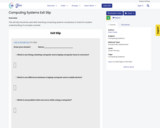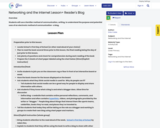
This exit slip should be used after teaching computing systems vocabulary to check for student understanding of concepts covered.
- Subject:
- Computing Systems
- Material Type:
- Activity/Lab
- Assessment
- Author:
- Erika Coble
- Date Added:
- 06/27/2022

This exit slip should be used after teaching computing systems vocabulary to check for student understanding of concepts covered.

Students and the teacher will work together to complete the Computing Systems Kahoot. Students will complete the Kahoot in a whole group setting, but will have their individual chromebooks to work from. The teacher will read the question and answers to each Kahoot, and students will select the correct choice on their individual chromebooks. As each question is completed have a whole group discussion about the correct answer choice.

The lessons included in the attached Google Slides incorporate standards from Computer Science, Math, Language Arts, and Physical Education. The lessons all focus on conditional statements (IF, THEN, ELSE) and can easily be adapted to fit any grade from kindergarten to fifth grade.

Set students up for programming success by creating a BeeBot anchor chart!These editable instructions will help students identify their role as planner or driver and set clear expectations of how Bee-Bot is used in computer programming. Tips:Introduce Bee-Bot whole classMake sure students understand the importance of the clear (x) button to erase the previous codealways press clear first to signal a new code (like how a capital letter signals the start of a new sentence) Plan the program in developmentally appropriate steps (some students program one step at a time, while others can program to the end goal)Turn the Bee-Bot off and use it as a game piece to write successful algorithmsHave students write their plan, or algorithm, on a whiteboard instead of using the cardsThe Bee-Bot emulator is perfect for guided practice!

Students will use a familiar method of communication, writing, to understand the purpose and potential uses of an electronic method of communication- a blog.

Patterns are hidden everywhere, and can help us read because we can predict what might happen quickly. Students will orally tell a fictional story in a sequential manner. Students will draw illustrations to match their story, and include some type of patterning (numerical, AB, cumulative story, etc).These materials were created by CodeVA in partnership with George Mason University and were funded by the National Science Foundation under Grant Award #1837380